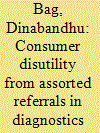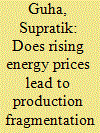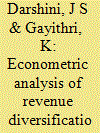| Srl | Item |
| 1 |
ID:
190833


|
|
|
|
|
| Summary/Abstract |
This article highlights the moral hazard problem in credence goods offered in the market as referral services. Credence goods are purchased with trust that is not observed. This examines if a penalty framework by authorities or transparency in tariff can offset moral hazard costs. A simple service unit cost model and its application to consumer expenditure data suggests that expected disutility to consumers are minimized in the penalty framework. The findings differ in the way consumers respond to transparency in tariffs, and could continue to bear moral hazard cost, as long as such units are unregistered in nature.
|
|
|
|
|
|
|
|
|
|
|
|
|
|
|
|
| 2 |
ID:
190834


|
|
|
|
|
| Summary/Abstract |
How does the price of energy affect the extent of production fragmentation in India’s manufacturing industries? The prevailing literature has engaged with production fragmentation and trade in middle products for a long time, but the relationship between energy prices and production fragmentation is less understood. This article deals with firm-level panel data of India’s manufacturing industries between 2005 and 2018 to estimate the impact of rising energy prices on the outsourcing decisions/production organization of the manufacturing firms. The article also uses a number of covariates, including wages, welfare expenses, sales, profit after tax, dividend rate, foreign exchange earnings and an interaction term between energy prices and foreign exchange earnings. The empirical results of this article indicate that larger firms tend to outsource production in part to smaller firms in order to cope with rising energy prices and keep their profitability intact. Static and dynamic panel estimates with a variety of robustness analyses support the main conjectures.
|
|
|
|
|
|
|
|
|
|
|
|
|
|
|
|
| 3 |
ID:
190832


|
|
|
|
|
| Summary/Abstract |
The key objective of this article is to empirically examine the trends and determinants of revenue diversification with respect to 14 major Indian states. The findings highlight a gradual decrease in the level of revenue diversification, which has become more visible in recent years. This indicates an erratic pattern of growth in tax and non-tax revenue sources. The panel cross-sectional–autoregressive distributed lag model test results reveal a positive contribution of economic and institutional factors, as compared to political factors, toward the process of revenue diversification. Overall, it is evident that cyclical fluctuations in the major tax revenue sources, coupled with a lessened emphasis on rationalising the structure of non-tax revenue sources, seem to have had an adverse impact on the process of revenue diversification on the part of states.
|
|
|
|
|
|
|
|
|
|
|
|
|
|
|
|
| 4 |
ID:
190831


|
|
|
|
|
| Summary/Abstract |
This study presents an analysis of the intra-regional performance of South Asian economies in terms of their productive efficiency during the period 1985–2019. A window data envelopment analysis (dea) based technique with bootstrapping is used to model the production frontier for seven South Asian economies to estimate their efficiency levels. The results show substantial differences in technical efficiency levels across South Asian economies and thus, the existence of vast potential to catch up with the best practices is revealed among these economies. On an average, the extent of technical inefficiency in south asia is about 46.92% per annum after adjusting for statistical bias. This is indicative of a huge gap in laggard and best practices within region. Both managerial and scale components of efficiency performance are equally responsible for observed production inefficiency in south asia. The existence of managerial inefficiency reflects failure of policy planners among affiliate countries to catch-up the best practices within South Asian region. However, the observed scale inefficiency (SIE) is because of the dominance of scale economies over diseconomies that urges need of enlarging cooperation among member nations.
|
|
|
|
|
|
|
|
|
|
|
|
|
|
|
|
| 5 |
ID:
190830


|
|
|
|
|
| Summary/Abstract |
The purpose of this study is to investigate the bilateral relationship among formal, informal and foreign direct investment (FDI) in the case of Sri Lanka during the period from 1990 to 2019. Using annual time series data, the Two Stage Least Square method is employed to investigate the relationship among the endogenous variables. The results derived from the analysis suggest that the integration between formal and informal sectors and formal sector and FDI are positive and have significant impacts on each other. However, the negative and significant impacts of the informal sector and FDI on each other further suggest that the integration between the informal sector and FDI did not give an optimistic signal to the country to contemplate that the informal sector is supporting foreign investors. At the same time, a sign that FDI discourages informal sector progression in the results has triggered the attention of further investigations on whether foreign investment agglomeration in Sri Lanka promotes informal-formal sectoral transformation at the cost of the informal sector. However, this study proposes an interest in sound policy requirements to reshape the informal sector towards the interest of foreign direct investors and informal-formal sector transformation.
|
|
|
|
|
|
|
|
|
|
|
|
|
|
|
|